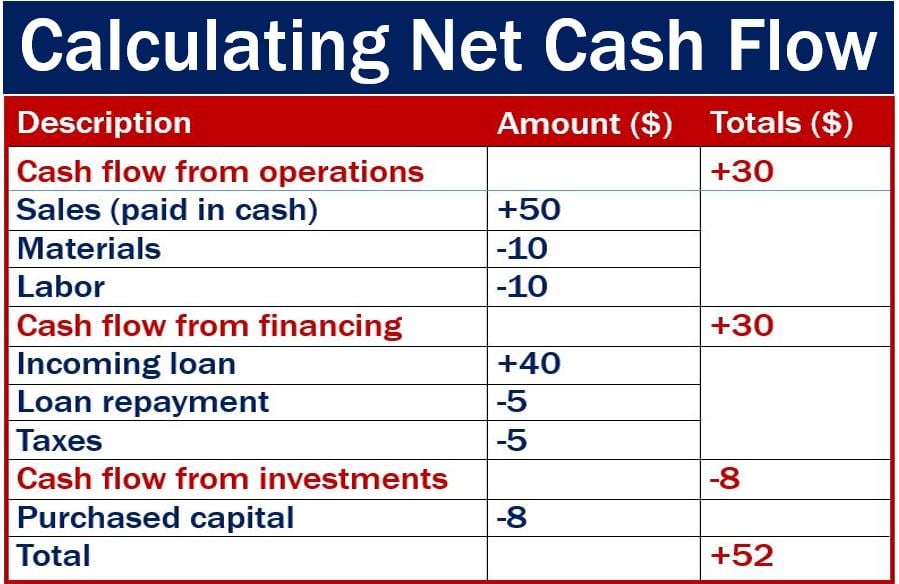Cash flow – definition and meaning
Cash flow is the movement of money in and out of a business or organization. Cash flow also refers to the flow of money in and out of an account. It is important because it helps evaluate the current value of a company. It is also crucial for determining the situation of a business. In fact, cash flow is essential to solvency.
Imagine a tank with a faucet (British: tap) above it and another faucet at its base. Water pours in from the faucet above. Water also pours out from the faucet at its base. The movement of the water is the tank’s ‘water flow.’ If that water were money, that movement would be the cash flow.
Do not confuse the term with ‘cash.’ Cash is the most liquid assets there is. For example, we classify coins, notes, traveler’s checks, short-term bank deposits, and other negotiable instruments as cash.
When more money is flowing in than flowing out, it is a sign of good financial health. It is a sign of good health both for businesses and private individuals.
With good cash flow, a company has plenty of cash on hand. Therefore, it can pay wages, suppliers, and other running expenses. The same goes for private individuals. We all need enough money flowing in to pay for our homes, cars, and other personal expenses.
Cash flow problems can cause businesses to die. For example, if there are outstanding invoices, but you have to pay your bills on time, you will have a cash flow problem. However, you will be fine for a while if you have an emergency fund.
It is crucial that businesses and individuals manage their cash flows carefully. In other words, we should all set aside money for an emergency fund.

We measure cash flows over specific periods, such as quarters, half years, or full years. The opening balance refers to how much cash was available at the beginning of a period.
The closing balance, on the other hand, was how much was available at the end of that period.
We measure the net cash flow over a period by calculating the change in cash balance over this period.
If the cash balance goes up, then it’s positive, and there is more available cash. However, it is negative if the cash balance drops.The cash balance refers to the amount of available cash there is.
Net cash flow
Net cash flow is the sum of the following:
Operational cash flows – cash that comes in through internal business activities. Examples include cash earnings and working capital changes. In fact, if this figure is negative, the company is insolvent.
Investment cash flows – cash coming in from the sale of long-life assets or capital expenditure.
Financing cash flows – cash we acquired from the issue of debt or paid out as dividends.
Liquidity vs. Cash Flow
Liquidity refers to an organization’s ability to meet its current liabilities. It meets its current liabilities using available current assets.
How well a firm performs in these two areas can affect its ability to operate. It also affects the company’s profitability.
Liquidity also refers to a business’ assets that we can easily convert into cash. An example of a liquid asset is a savings account.
Liquidity can impact cash flow. What happens if a company does not have enough cash to pay a bill? One option is to liquidate an asset to raise the amount of cash on hand.
The moment it turns an asset into cash, the amount of money coming in increases. In other words, one part of the company’s cash flow improves.
Warren Buffett, an American business magnate, and investor, once said:
“I do not like debt and do not like to invest in companies that have too much debt, particularly long-term debt. With long-term debt, increases in interest rates can drastically affect company profits and make future cash flows less predictable.”
A company without enough cash to pay its immediate obligations is illiquid. A security or asset that we cannot convert into cash rapidly is also illiquid.

Why is cash flow important?
- It allows you to determine the rate of return or value of a project.
- We measure it to assess liquidity problems. Being profitable is great. However, it does not always mean a business is liquid.
- Accountants use cash flow statements to determine profits. Sometimes accrual accounting concepts may not accurately portray economic realities.
- To assess what percentage of net income consists of non-cash items (which would make it low quality).
- For risk evaluation.
Factoring
Factoring, a type of financing in which a ‘factor’ buys your invoices, is useful for businesses with cash flow problems.
The factor gives you between 70% and 85% of the invoice’s value immediately, and collects the money from your customer. When your customer has paid, you receive the remainder of the money.
The factor charges a percentage of the invoice’s value as a fee.
Factoring is also useful for small companies because they can free up staff. In other words, rather than spend time chasing late payers, they can focus on other aspects of the business. The factor does all the credit control work.

